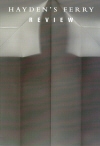Chtenia – Winter 2014
“No one can embrace the unembraceable,” the editors of Chtenia commented on the task of reading for this issue, “Storied Moscow.” Indeed, Moscow evokes a rush of impressions like no other city: six-month winters, intrigue, people from Tashkent and Minsk rubbing elbows and trading blows, the center of violence, dreams, disappointments, and majesty for so many. I’m willing to bet that the Stolichnaya (“of the capital”) brand of vodka wouldn’t ring with the same aplomb if it were associated with, say, Washington, D.C. or Ottawa. The editors have done an admirable job of going beyond the familiar, however; the pieces in the issue range from historical records to writers who are hardly known outside Russia, to the lesser-known works of famous writers as well as snippets of Pushkin and Okudzhava in a new spotlight. The quirky volume makes me feel as if I’d just stumbled into a dusty section of the library, opened a worn hardcover that hadn’t been checked out since 1957, and discovered a treasure trove. Continue reading “Chtenia – Winter 2014”

 Printed on the back cover of this issue of Hayden’s Ferry Review appears, along with front and back cover art by Carlos Jiménez Cahua, the word “DEPARTURE” broken into three lines: DEP / ART / URE, and I noticed this one afternoon picking up the issue from the coffee table. I had already become somewhat familiar with the contents of the issue, and my brain reversed the fragments of the word, reading from the bottom up: Your Art Dep(artment).
Printed on the back cover of this issue of Hayden’s Ferry Review appears, along with front and back cover art by Carlos Jiménez Cahua, the word “DEPARTURE” broken into three lines: DEP / ART / URE, and I noticed this one afternoon picking up the issue from the coffee table. I had already become somewhat familiar with the contents of the issue, and my brain reversed the fragments of the word, reading from the bottom up: Your Art Dep(artment).